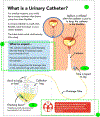Developing an educational resource for parents on pediatric catheter-associated urinary tract infection (CAUTI) prevention
- PMID: 34543706
- PMCID: PMC8959581
- DOI: 10.1016/j.ajic.2021.09.006
Developing an educational resource for parents on pediatric catheter-associated urinary tract infection (CAUTI) prevention
Abstract
Background: Pediatric catheter-associated urinary tract infection (CAUTI) prevention guidelines encourage family engagement; however, there is a dearth of research on parent-facing CAUTI prevention resources. We aimed to meet the learning needs of parents about CAUTI prevention in the hospital by developing and refining an educational pamphlet with parents.
Methods: Phase 1: We compiled existing evidence from CAUTI prevention guidelines and conducted a focus group with parents to form learning objectives. Phase 2: We developed prototype design elements, tested initial designs with a survey, and conducted qualitative participatory design sessions with parents to iteratively refine the pamphlet until design saturation was reached.
Results: We identified the following key themes and preferences: (1) Clear boundaries for engagement (e.g., parents would not be emptying the catheter); (2) Positive, actionable framing (e.g., what should proper catheter positioning look like?); (3) What to expect (e.g., is the catheter painful for my child?); (4) Parents considered both their and their child's comprehension of the content when providing feedback.
Conclusions: Overall, we demonstrated the utility of remote participatory design methods in developing and refining a CAUTI prevention resource based on parents' preferences. Future research should consider adapting these methods and implementing formal evaluation for comprehension for eventual integration into clinical practice.
Keywords: Catheter-associated urinary tract infections; Healthcare-associated infections; Infection prevention; Patient and family engagement; Patient safety; Pediatric.
Copyright © 2021 Association for Professionals in Infection Control and Epidemiology, Inc. Published by Elsevier Inc. All rights reserved.
Conflict of interest statement
Conflicts of Interest
The authors have no conflicts of interest to declare in relation to the present manuscript.
Figures




References
-
- Mack EH, Stem CT. Prevention of CAUTIs, CLABSIs, and VAPs in Children. Curr Treat Options Pediatr. 2017;3(3):221–235. doi:10.1007/s40746-017-0094-8 - DOI
-
- Centers for Disease Control and Prevention. Catheter-associated Urinary Tract Infections (CAUTI). https://www.cdc.gov/hai/ca_uti/uti.html. Published 2015.
-
- Association for Professionals in Infection Control and Epidemiology. Guide to Preventing Catheter-Associated Urinary Tract Infections. 2014.

